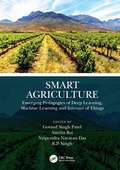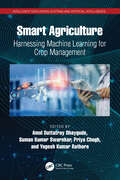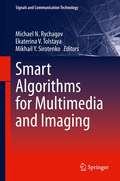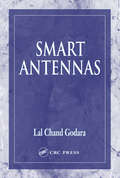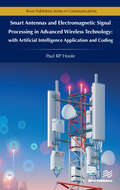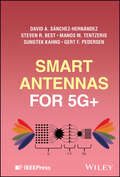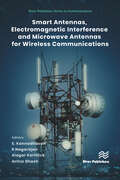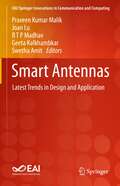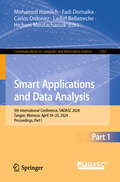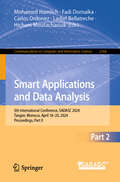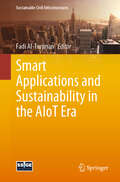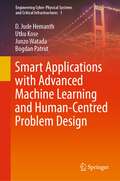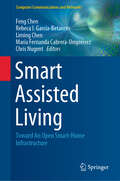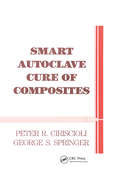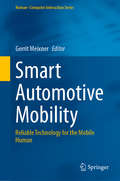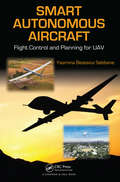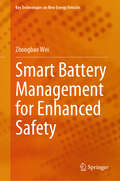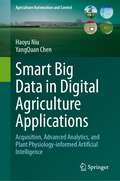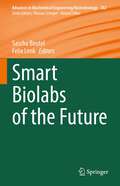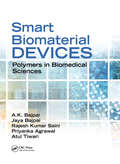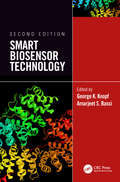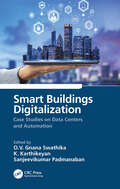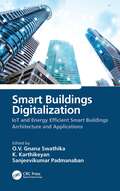- Table View
- List View
Smart Agriculture: Emerging Pedagogies of Deep Learning, Machine Learning and Internet of Things
by Govind Singh PatelThis book endeavours to highlight the untapped potential of Smart Agriculture for the innovation and expansion of the agriculture sector. The sector shall make incremental progress as it learns from associations between data over time through Artificial Intelligence, deep learning and Internet of Things applications. The farming industry and Smart agriculture develop from the stringent limits imposed by a farm's location, which in turn has a series of related effects with respect to supply chain management, food availability, biodiversity, farmers' decision-making and insurance, and environmental concerns among others. All of the above-mentioned aspects will derive substantial benefits from the implementation of a data-driven approach under the condition that the systems, tools and techniques to be used have been designed to handle the volume and variety of the data to be gathered. Contributions to this book have been solicited with the goal of uncovering the possibilities of engaging agriculture with equipped and effective profound learning algorithms. Most agricultural research centres are already adopting Internet of Things for the monitoring of a wide range of farm services, and there are significant opportunities for agriculture administration through the effective implementation of Machine Learning, Deep Learning, Big Data and IoT structures.
Smart Agriculture: Harnessing Machine Learning for Crop Management (Intelligent Data-Driven Systems and Artificial Intelligence)
by Suman Kumar Swarnkar Yogesh Kumar Rathore Amol Dattatray Dhaygude Priya ChughThis book, Smart Agriculture: Harnessing Machine Learning for Crop Management, is a comprehensive guide designed to explore the various facets of integrating machine learning into agricultural practices. It aims to provide readers with a solid foundation in machine learning concepts while demonstrating their practical applications in real-world farming scenarios. It also examines the role of remote monitoring and precision agriculture, highlighting how technologies such as remote sensing and recurrent neural networks can optimize farming practices.This book:· Emphasizes sustainable agricultural practices and data-driven decision-making for eco-friendly farming. · Highlights the importance of using environmentally friendly practices, and how machine learning can play a pivotal role in achieving sustainability goals. · Discusses topics such as crop optimization, disease detection, pest control, resource management, precision agriculture, and sustainability. · Covers predictive analytics for weather forecasting, Internet of Things applications for precision agriculture, and the role of sensors in data collection. · Illustrates optimizing resource allocation, irrigation with artificial intelligence, and machine learning for soil health assessment. Whether you are a researcher, a student, an agricultural professional, or a technology enthusiast, this book offers valuable insights into the transformative power of machine learning in agriculture. It invites readers to explore the potential of machine learning to transform farming practices, improve food security, and promote environmental sustainability.
Smart Algorithms for Multimedia and Imaging (Signals and Communication Technology)
by Michael N. Rychagov Ekaterina V. Tolstaya Mikhail Y. SirotenkoThis book presents prospective, industrially proven methods and software solutions for storing, processing, and viewing multimedia content on digital cameras, camcorders, TV, and mobile devices. Most of the algorithms described here are implemented as systems on chip firmware or as software products and have low computational complexity and memory consumption. In the four parts of the book, which contains a total of 16 chapters, the authors address solutions for the conversion of images and videos by super-resolution, depth estimation and control and mono-to-stereo (2D to 3D) conversion; display applications by video editing; the real-time detection of sport episodes; and the generation and reproduction of natural effects. The practical principles of machine learning are illustrated using technologies such as image classification as a service, mobile user profiling, and automatic view planning with dictionary-based compressed sensing in magnetic resonance imaging. The implementation of these technologies in mobile devices is discussed in relation to algorithms using a depth camera based on a colour-coded aperture, the animated graphical abstract of an image, a motion photo, and approaches and methods for iris recognition on mobile platforms. The book reflects the authors’ practical experience in the development of algorithms for industrial R&D and the commercialization of technologies.Explains digital techniques for digital cameras, camcorders, TV, mobile devices;Offers essential algorithms for the processing pipeline in multimedia devices and accompanying software tools;Features advanced topics on data processing, addressing current technology challenges.
Smart Antennas (Electrical Engineering And Applied Signal Processing Ser.)
by Lal Chand GodaraThe use of smart antennas to increase mobile communications channels has re-ignited research and development in the field. Practicing engineers are eager to discover more about this subject, and need a comprehensive book that can provide a learning platform and prevent the loss of time spent on searches through journal literature.Smart Ante
Smart Antennas and Electromagnetic Signal Processing in Advanced Wireless Technology
by Paul R.P. HooleThe book addresses the current demand for a scientific approach to advanced wireless technology and its future developments. It gives a clear presentation of both antennas and adaptive signal processing which is what makes antennas powerful, maneuverable and necessary for advanced wireless technology. The book presents electromagnetic signal processing techniques that both control the antenna beam and track the moving station, which is required for effective, fast, dynamic beamforming.The first part of the book presents a comprehensive description and analysis of basic antenna theory, starting from short dipole antennas to array antennas. This section also includes important concepts related to antenna parameters, electromagnetic wave propagation, the Friis equation, the radar equation and wave reflection and transmission through media.The second part of the book focuses on smart antennas, commencing from a look at the traditional approach to beamforming before getting into the details of smart antennas. Complete derivation and description of the techniques for electromagnetic field signal processing techniques for adaptive beamforming are also presented. Artificial Intelligence (AI) driven beamforming is presented using computationally fast and low-memory demanding technique for AI beamforming is presented with the different excitation functions available. A novel method for fast, low memory and accurate, maneuverable single beam generation is presented, as well as other methods for beamforming with fewer elements along with a simple method for tracking the mobile antenna and station. In this section, for completeness, the use of antenna signal processing for synthetic aperture techniques for imaging is also presented, specifically the Inverse Synthetic Aperture Imaging technique.The third part of the book presents technological aspects of advanced wireless technology, including the 5G wireless system and the various devices needed to construct it. While the books’ main emphasis is theoretical understanding and design, it includes applications, and legal matters are also presented.
Smart Antennas for 5G+
by Manos M. Tentzeris Steven R. Best Gert F. Pedersen David A. Sánchez-Hernández Sungtek KahngComprehensive reference text for the development of advanced antenna systems for 5G and beyond Smart Antennas for 5G+ addresses the transformation that simple, conventional antennas have gone through to fulfill the complex and challenging performance expectations of 5G wireless communications and beyond. It also describes the 5G physical layer including the gNodeB, basics of the propagation channel, and user equipment (UE) specific antenna aspects. The authors present various broadband antennas covering mmW bands for 5G+ and B5G applications, explore recent developments in array calibration and plane wave generators, and consider future challenges for 5G+ radio system testing. Novel key performance indicators in which not only conventional RF parameters, but also other parameters and overall radio performance, are examined. The huge shrinkage which was prioritized in 4G modules are now combined with extremely versatile and precise beamforming capacities, thermal mitigation, and link budget compensation design strategies that bring antennas into a new era. As such, antenna integration, flexible and 3D printed elements, the use of metamaterials, and advanced testing of new features are key elements of this book. Additional topics covered in Smart Antennas for 5G+ include: Beamforming, beam-steering, power control, cell breathing, and many other 5G concepts that make the evaluation of a 5G antenna structure a complex process Multi-probe anechoic chamber, reverberation chamber, and wireless cable solutions, RF testing of the 5G antenna systems, and small-cell repeaters for 5G/B5G beamforming Powering and sensing applications in 5G+ printed electronic steerable antenna arrays for reconfigurable intelligent surfaces that stem from metasurfaces 3GPP/ITU standards and models for 5G MIMO base station antennas, propagation channel modeling, and link budget considerations The connection between complex but realistically used designs and the way testing has evolved to determine the value of novel designs makes Smart Antennas for 5G+ a must-have resource for advanced engineers as well as newcomers in the field of 5G wireless communications.
Smart Antennas, Electromagnetic Interference and Microwave Antennas for Wireless Communications
by R. Nagarajan S. Kannadhasan Alagar Karthick Aritra GhoshThis book covers all areas of smart antennas, electromagnetic interference, and microwave antennas for wireless communications. Smart antennas or adaptive antennas are multi-antenna components on one or both sides of a radio communication connection, combined with advanced signal processing algorithms. They've evolved into a critical technology for third-generation and beyond mobile communication systems to meet their lofty capacity and performance targets. It seems that a significant capacity gain is achievable, particularly if they are employed on both sides of the connection. There are several essential characteristics of these systems that need scientific and technical investigation. Included in the book are beamforming, massive MIMO, network MIMO, mmwave transmission, compressive sensing, MIMO radar, sensor networks, vehicle-to-vehicle communication, location, and machine learning.
Smart Antennas: Latest Trends in Design and Application (EAI/Springer Innovations in Communication and Computing)
by Praveen Kumar Malik Joan Lu B T P Madhav Geeta Kalkhambkar Swetha AmitThis book presents the latest techniques for the design of antenna, focusing specifically on the microstrip antenna. The authors discuss antenna structure, defected ground, MIMO, and fractal design. The book provides the design of microstrip antenna in terms of latest applications and uses in areas like IoT and device-to-device communication. The book also provides the current methods and techniques used for the enhancement of the performance parameters of the microstrip antenna. Chapters enhance the knowledge and skills of students and researchers in the latest in the communications world like IoT, D2D, satellite, wearable devices etc. The authors discuss applications such as microwave imaging, medical implants, hyperthermia treatments, and wireless wellness monitoring and how a decrease in size of antenna help facilitate application potential.Provides the latest techniques used for the design of antenna in terms of its structure, defected ground, MIMO and fractal design;Outlines steps to resolve issues with designing antenna, including the latest design and design parameters for microstrip antenna;Presents the design of conformal and miniaturized antenna structures for various applications.
Smart Applications and Data Analysis: 5th International Conference, SADASC 2024, Tangier, Morocco, April 18–20, 2024, Proceedings, Part I (Communications in Computer and Information Science #2167)
by Ladjel Bellatreche Carlos Ordonez Mohamed Hamlich Fadi Dornaika Hicham MoutachaouikThis two-volume set CCIS 2167-2168 constitutes the proceedings of the 5th International Conference on Smart Applications and Data Analysis, SADASC 2024, held in Tangier, Morocco, in April 2024. The 30 full papers presented together with 10 short papers were carefully reviewed and selected from 91 submissions. They cover the following topics: designing and modeling; data management; tinyML and anomaly detection; network technologies and IOT; control, dynamic systems and optimisation; and exploitation and exploration.
Smart Applications and Data Analysis: 5th International Conference, SADASC 2024, Tangier, Morocco, April 18–20, 2024, Proceedings, Part II (Communications in Computer and Information Science #2168)
by Ladjel Bellatreche Carlos Ordonez Mohamed Hamlich Fadi Dornaika Hicham MoutachaouikThis two-volume set CCIS 2167-2168 constitutes the proceedings of the 5th International Conference on Smart Applications and Data Analysis, SADASC 2024, held in Tangier, Morocco, in April 2024. The 30 full papers presented together with 10 short papers were carefully reviewed and selected from 91 submissions. They cover the following topics: designing and modeling; data management; tinyML and anomaly detection; network technologies and IOT; control, dynamic systems and optimisation; and exploitation and exploration.
Smart Applications and Sustainability in the AIoT Era (Sustainable Civil Infrastructures)
by Fadi Al-TurjmanThis book gathers recent research work on emerging Artificial Intelligence (AI) methods for processing and storing data generated by smart infrastructures. Smart infrastructures gather Terabytes of data nowadays with no need for traditional control. The data automatically uploads to the cloud computing platform. The cloud analyses the data and generates the required output in visualization, graph, and action. A remote access network can be constructed dependent on either low-elevation or high-altitude stages. When associated with satellite and earthly frameworks, these stages empower a far-reaching access network with worldwide inclusion and diverse administration provisioning. Data analytics are used in agriculture, mining, waste management, energy, and military defenses. Major topics covered include the analysis and development of AI-powered mechanisms in future IoT and smart infrastructures applications. Further, the book addresses new technological developments, current research trends, and industry needs. Presenting case studies, experience and evaluation reports, and best practices in utilizing AI applications in IoT networks, it strikes a good balance between theoretical and practical issues. It also provides technical/scientific information on various aspects of AI technologies, ranging from basic concepts to research grade material, including future directions. The book is intended for researchers, practitioners, engineers and scientists involved in the design and development of protocols and AI applications for smart and sustainable infrastructure-related devices.
Smart Applications with Advanced Machine Learning and Human-Centred Problem Design (Engineering Cyber-Physical Systems and Critical Infrastructures #1)
by Junzo Watada D. Jude Hemanth Bogdan Patrut Utku KoseThis book brings together the most recent, quality research papers accepted and presented in the 3rd International Conference on Artificial Intelligence and Applied Mathematics in Engineering (ICAIAME 2021) held in Antalya, Turkey between 1-3 October 2021. Objective of the content is to provide important and innovative research for developments-improvements within different engineering fields, which are highly interested in using artificial intelligence and applied mathematics. As a collection of the outputs from the ICAIAME 2021, the book is specifically considering research outcomes including advanced use of machine learning and careful problem designs on human-centred aspects. In this context, it aims to provide recent applications for real-world improvements making life easier and more sustainable for especially humans. The book targets the researchers, degree students, and practitioners from both academia and the industry.
Smart Architecture – A Sustainable Approach for Transparent Building Components Design
by Valentina FrighiThis book explores the specific role that glazing technologies play within the world of smart architecture as important components of contemporary and future sustainable architectural and technological research. Smart Architecture begins with a definition of the concept of “smart” in architecture and examines how innovative technologies and materials have shaped buildings over the years. The author then provides a supporting database of contemporary smart architecture—mapping adopted strategies, recognizing common patterns, and evaluating current and future trends in the context of smart building envelopes, energy efficiency, and the development of high-potential innovative building components. The book proceeds with a focus on the specific role that glazing technologies play in this framework and provides a systematic methodology to quantify options for the effective integration of transparent building components within advanced and innovative building envelope systems.
Smart Assisted Living: Toward An Open Smart-Home Infrastructure (Computer Communications and Networks)
by Feng Chen Liming Chen Rebeca I. García-Betances María Fernanda Cabrera-Umpiérrez Chris NugentSmart Homes (SH) offer a promising approach to assisted living for the ageing population. Yet the main obstacle to the rapid development and deployment of Smart Home (SH) solutions essentially arises from the nature of the SH field, which is multidisciplinary and involves diverse applications and various stakeholders. Accordingly, an alternative to a one-size-fits-all approach is needed in order to advance the state of the art towards an open SH infrastructure.This book makes a valuable and critical contribution to smart assisted living research through the development of new effective, integrated, and interoperable SH solutions. It focuses on four underlying aspects: (1) Sensing and Monitoring Technologies; (2) Context Interference and Behaviour Analysis; (3) Personalisation and Adaptive Interaction, and (4) Open Smart Home and Service Infrastructures, demonstrating how fundamental theories, models and algorithms can be exploited to solve real-world problems.This comprehensive and timely book offers a unique and essential reference guide for policymakers, funding bodies, researchers, technology developers and managers, end users, carers, clinicians, healthcare service providers, educators and students, helping them adopt and implement smart assisted living systems.
Smart Autoclave Cure of Composites
by George S. Springer Peter R. CiriscioliThis book describes process models for thermosetting and thermoplastic matrix composites and an expert system applicable to autoclave curing of thermosetting matrix composites. It presents a rule based expert system that can be used for real time control of the autoclave temperature and pressure.
Smart Automotive Mobility: Reliable Technology for the Mobile Human (Human–Computer Interaction Series)
by Gerrit MeixnerThis book focuses on smart results in the field of smart automotive mobility concentrating on (semi-)autonomous cars. The results are based on 5 recently finished public-funded research projects with a budget of over 15 million Euro. Providing insights into the next generation of personalized mobility on the road the authors discuss personalized, adaptive cooperative systems for highly automated cars and how they can be developed in a human-centered way. Furthermore, the book reports on a cooperative driver-vehicle interaction. How can the driver and the vehicle support each other? What are their best skills and how can they benefit from each other? It also gives novel insights on intuitive steering gestures on the steering wheel which initiate maneuvers to be executed by the automation, and to be supervised by, influenced or interrupted by the driver. The book finishes with information on a cooperative laser beam system which improves the communication between the different road participants to optimize the road safety of tomorrow. Smart Automotive Mobility: Reliable Technology for the Mobile Human is an ideal source for researchers, students and practitioners working in the area of intelligent systems for the automotive industry. It gives valuable and condensed information from multi-million Euro research projects funded by the German Federal Ministry of Education and Research.
Smart Autonomous Aircraft: Flight Control and Planning for UAV
by Yasmina Bestaoui SebbaneWith the extraordinary growth of Unmanned Aerial Vehicles (UAV) in research, military, and commercial contexts, there has been a need for a reference that provides a comprehensive look at the latest research in the area. Filling this void, Smart Autonomous Aircraft: Flight Control and Planning for UAV introduces the advanced methods of flight contr
Smart Battery Management for Enhanced Safety (Key Technologies on New Energy Vehicles)
by Zhongbao WeiThis book consolidates studies in the rapidly and foreseeably growing field of battery management. The primary focus is to overview the management of batteries (Li-ion batteries and some cases of flow batteries) with the fusion of mechanism and AI-based approaches. The book can be categorized into three groups, i.e., (i) mechanism and AI-based battery modeling and parameterization, (ii) AI-based diagnostic, early warning, and active safety control, and (iii) emerging techniques of smart battery and smart management, combining the emerging areas of embedded sensing and reconfigurable batteries. It is well recognized that the battery safety and management are the kernel of energy storage, renewable utilization, and low-carbon society, which have been highly popular in recent years. The exploration of AI techniques for advanced battery management has been seldom discussed systematically before. Moreover, the combination of AI and mechanism approaches can remarkably enhance the battery management, which however has never been focused on in previous books. Therefore, this book can add new knowledge to the paradigm and attract the attention of academics, scientists, engineers, and practitioners. It is a reference book for researchers and engineers in related fields. The step-by-step guidance, comprehensive introduction, and case studies make it accessible to audiences of different levels, from graduates to experienced engineers.
Smart Big Data in Digital Agriculture Applications: Acquisition, Advanced Analytics, and Plant Physiology-informed Artificial Intelligence (Agriculture Automation and Control)
by YangQuan Chen Haoyu NiuIn the dynamic realm of digital agriculture, the integration of big data acquisition platforms has sparked both curiosity and enthusiasm among researchers and agricultural practitioners. This book embarks on a journey to explore the intersection of artificial intelligence and agriculture, focusing on small-unmanned aerial vehicles (UAVs), unmanned ground vehicles (UGVs), edge-AI sensors and the profound impact they have on digital agriculture, particularly in the context of heterogeneous crops, such as walnuts, pomegranates, cotton, etc. For example, lightweight sensors mounted on UAVs, including multispectral and thermal infrared cameras, serve as invaluable tools for capturing high-resolution images. Their enhanced temporal and spatial resolutions, coupled with cost effectiveness and near-real-time data acquisition, position UAVs as an optimal platform for mapping and monitoring crop variability in vast expanses. This combination of data acquisition platforms and advanced analytics generates substantial datasets, necessitating a deep understanding of fractional-order thinking, which is imperative due to the inherent “complexity” and consequent variability within the agricultural process. Much optimism is vested in the field of artificial intelligence, such as machine learning (ML) and computer vision (CV), where the efficient utilization of big data to make it “smart” is of paramount importance in agricultural research. Central to this learning process lies the intricate relationship between plant physiology and optimization methods. The key to the learning process is the plant physiology and optimization method. Crafting an efficient optimization method raises three pivotal questions: 1.) What represents the best approach to optimization? 2.) How can we achieve a more optimal optimization? 3.) Is it possible to demand “more optimal machine learning,” exemplified by deep learning, while minimizing the need for extensive labeled data for digital agriculture? This book details the foundations of the plant physiology-informed machine learning (PPIML) and the principle of tail matching (POTM) framework. It is the 9th title of the "Agriculture Automation and Control" book series published by Springer.
Smart Bioenergy
by Daniela ThränBiomass is a vital source of renewable energy, because it offers a wide range of established and potential methods for energy generation. It is also an important facet of the progression toward a sustainable energy future. The need for further development in the provision of bioenergy is underlined by challenges affecting the biomass resource base, including rising demand for biomass for food, feed, materials and fuel. This is underlined by significant concerns over factors relating to land, such as soil, nutrients and biodiversity. This book examines and analyzes Germany's decade-long initiative toward implementation of an active policy for the transition of the energy system to make greater use of renewable energy sources, which has resulted in a significant increase in the amount of biomass used for electricity, heat and transport fuel. The book begins with a review of market and resource base issues and moves on to analyze the technical options for a more integrated bioenergy use. The analysis spans the entire bioenergy provision chain including solid, liquid and gaseous biofuels. A case study offers a detailed model of the effects of smart biomass energy on the German energy system. The book closes with a view of the most promising fields and an appraisal of needed elements for a successful transition.
Smart Biolabs of the Future (Advances in Biochemical Engineering/Biotechnology #182)
by Sascha Beutel Felix LenkThis book reviews the advances in data gathering and processing in the biotech laboratory environment, and it sheds new lights on the various aspects that are necessary for the implementation of intelligent laboratory architecture and infrastructure. Smart technologies are increasingly dominating our everyday lives and have become an indispensable part of the industrial environment. The laboratory environment, which has long been rather conservative, has also set out to adapt smart technologies with regards to Industry 4.0 and the Internet of Things (IoT) for the laboratory. Due to the heterogeneity of the existing infrastructure and the often complex work processes, standardization is slow, e.g. to implement device interfaces or standardized driver protocols, which are urgently needed to generate standardized data streams that would be immanent for post-processing of data.Divided into 9 chapters, this book offers an authoritative overview of the diverse aspects in the generation and recording of uniform data sets in the laboratory, and in the processing of the data and enabling seamless processing towards machine learning and artificial intelligence. In the first part of the book, readers will find more about high throughout systems, automation, robotics, and the evolution of technology in the laboratory. The second part of the book is devoted to standardization in lab automation, in which readers will learn more about some regulatory aspects, the SiLA2 standards, the OPC LADS (Laboratory and Analytical Device Standard), and FAIR Data infrastructure
Smart Biomaterial Devices: Polymers in Biomedical Sciences
by Atul Tiwari A.K. Bajpai Jaya Bajpai Rajesh Kumar Saini Priyanka AgrawalPolymers have emerged as one of the most innovative classes of materials in modern materials science, leading to new applications in medicine and pharmacy. This book offers a convincing and understandable approach to polymer biomaterial devices being used in various areas related to biomedical and pharmaceutical fields. The polymer materials finding application as biomaterials are discussed and described in detail pertaining to the areas of artificial implants, orthopedics, ocular devices, dental implants, drug delivery systems, burns and wounds.
Smart Biosensor Technology
by George K. Knopf Amarjeet S. BassiBased on the success of the first edition, this second edition continues to build upon fundamental principles of biosensor design and incorporates recent advances in intelligent materials and novel fabrication techniques for a broad range of real world applications. The book provides a multi-disciplinary focus to capture the ever-expanding field of biosensors. Smart Biosensor Technology, Second Edition includes contributions from leading specialists in a wide variety of fields with a common focus on smart biosensor design. With 21 chapters organized in five parts, this compendium covers the fundamentals of smart biosensor technology, important issues related to material design and selection, principles of biosensor design and fabrication, advances in bioelectronics, and a look at specific applications related to pathogen detection, toxicity monitoring, microfluidics and healthcare. Features Provides a solid background in the underlying principles of biosensor design and breakthrough technologies for creating more intelligent biosensors Focusses on material design and selection including cutting-edge developments in carbon nanotubes, polymer nanowires, and porous silicon Examines machine learning and introduces concepts such as DNA-based molecular computing for smart biosensor function Explores the principles of bioelectronics and nerve cell microelectrode arrays for creating novel transducers and physiological biosensors Devotes several chapters to biosensors developed to detect and monitor a variety of toxins and pathogens Offers expert opinions on the future directions, challenges and opportunities in the field
Smart Buildings Digitalization: Case Studies on Data Centers and Automation
by O.V. Gnana SwathikaThis book explains the concept of data centers, including data collection, public parking systems, smart metering, and sanitizer dispensers. Electric urban transport systems and effective electric distribution in smart cities are discussed as well. The extensive role of power electronics in smart building applications, such as electric vehicles, rooftop terracing, and renewable energy integration, is included. Case studies on automation in smart homes and commercial and official buildings are elaborated. This book describes the complete implication of smart buildings via industrial, commercial, and community platforms. FEATURES Systematically defines energy-efficient buildings employing power consumption optimization techniques with the inclusion of renewable energy sources Covers data centers and cybersecurity with excellent data storage features for smart buildings Includes systematic and detailed strategies for building air-conditioning and lighting Details smart building security propulsion This book is aimed at graduate students, researchers, and professionals in building systems engineering, architectural engineering, and electrical engineering.
Smart Buildings Digitalization: IoT and Energy Efficient Smart Buildings Architecture and Applications
by O.V. Gnana SwathikaThis book discusses various artificial intelligence and machine learning applications concerning smart buildings. It includes how renewable energy sources are integrated into smart buildings using suitable power electronic devices. The deployment of advanced technologies with monitoring, protection, and energy management features is included, along with a case study on automation. Overall, the focus is on architecture and related applications, such as power distribution, microgrids, photovoltaic systems, and renewable energy aspects. The chapters define smart building concepts and their related benefits. FEATURES Discusses various aspects of the role of the Internet of things (IoT) and machine learning in smart buildings Explains pertinent system architecture and focuses on power generation and distribution Covers power-enabling technologies for smart cities Includes photovoltaic system-integrated smart buildings This book is aimed at graduate students, researchers, and professionals in building systems engineering, architectural engineering, and electrical engineering.
